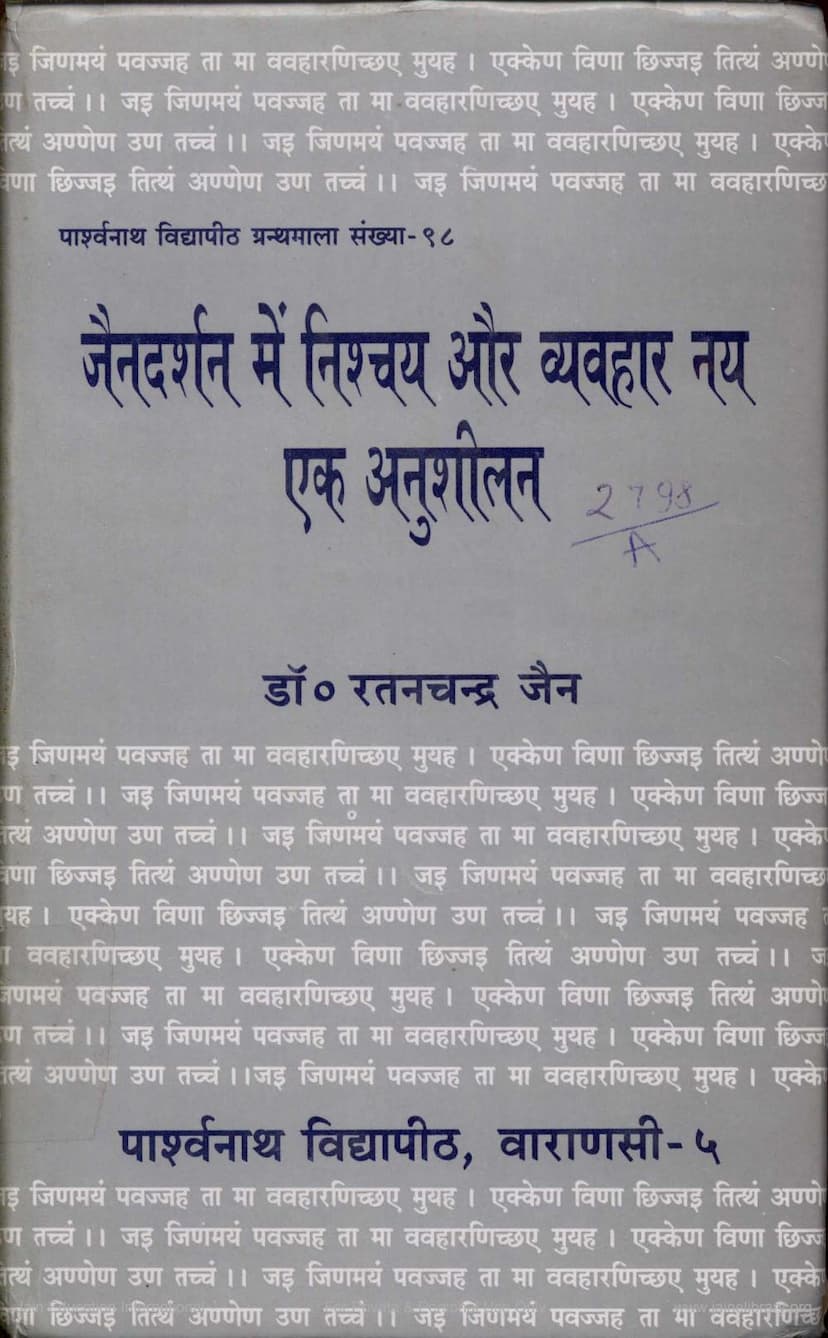Jain Darshan Me Nischay Aur Vyavahar Nay Ek Anushilan
Added to library: September 1, 2025

Summary
Here's a comprehensive summary of the Jain text "Jain Darshan me Nischay aur Vyavahar Nay Ek Anushilan" by Ratanchand Jain, based on the provided text:
Book Title: Jain Darshan me Nischay aur Vyavahar Nay Ek Anushilan (A Study of Nischaya and Vyavahara Nayas in Jain Philosophy) Author: Dr. Ratan Chandra Jain Publisher: Parshwanath Shodhpith, Varanasi Publication Year: 1997
This book, authored by Dr. Ratan Chandra Jain, is a scholarly exploration of the fundamental concepts of Nischaya Nay (Absolute Viewpoint) and Vyavahara Nay (Conventional Viewpoint) within Jain philosophy. The author, drawing upon extensive study and deliberation with scholars, presents a refined and expanded version of his doctoral thesis. The central argument of the book is that these two nayas (viewpoints) are not contradictory but rather complementary and essential for understanding reality and achieving liberation (moksha).
Core Concepts and Arguments:
-
Interdependence of Nischaya and Vyavahara: The book strongly emphasizes that Nischaya and Vyavahara Nay are mutually dependent and inseparable. One cannot grasp the complete truth by relying solely on one nay while discarding the other.
-
Nature of Nischaya Nay:
- Nischaya Nay reveals the inherent, essential, and natural state of the soul (atma).
- It focuses on the soul's self-nature, its fundamental essence, its fundamental characteristics, its non-duality with its essential attributes, its inherent nature, and its self-reliant state.
- It negates accidental or superimposed qualities, such as the soul's identification with the body, karma, or external possessions.
- It highlights the soul's true nature as pure consciousness, devoid of all impurities and external attachments.
- In terms of the path to liberation, Nischaya points to the direct, intrinsic path to moksha, focusing on the soul's pure, liberated state.
-
Nature of Vyavahara Nay:
- Vyavahara Nay describes the soul's state in the empirical world, in its state of bondage and worldly existence.
- It deals with the soul's apparent conditions, its incidental states, its external relations, its apparent distinctions, and the conventional or practical reality.
- It acknowledges the soul's apparent involvement with the body, karma, external relationships, and conventional designations.
- It recognizes the soul's apparent agency and experience in the cycle of birth and death.
- It describes the conventional path to liberation, which involves ethical conduct, religious practices, and the gradual purification of the soul.
-
Interdependence in the Path to Moksha:
- Nischaya Nay (absolute path) is the ultimate goal and the direct means to liberation, but it is not achievable without the preparatory steps outlined by Vyavahara Nay.
- Vyavahara Nay (conventional path) serves as the means to achieve the state described by Nischaya Nay. It is like medicine for the disease of impure passions, leading towards the state of pure passions.
- The book argues that following Nischaya Nay alone can lead to a detachment from worldly duties and practices, while following Vyavahara Nay alone without the ultimate goal of Nischaya leads to attachment to worldly actions.
- Therefore, a balanced and integrated approach, following both nayas in their proper sequence and context, is crucial for successful spiritual progress.
-
Relativity and Application:
- Nischaya Nay is not possible to follow in lower stages of spiritual development, while Vyavahara Nay becomes redundant in higher stages where the absolute realization is attained.
- Right faith (Samyaktva) combined with auspicious mental application (shubha-upayoga) leads to the accumulation of merit (punya) and, ultimately, to liberation. Right faith without auspicious application only leads to merit.
- Abandoning Nischaya Nay prevents understanding the fundamental nature of reality, while abandoning Vyavahara Nay makes progression on the spiritual path impossible.
-
Addressing Controversies: The book meticulously addresses and refutes various contradictory interpretations and debates prevalent among scholars regarding Nischaya and Vyavahara Nay. These include:
- The nature of Asadbhoot Vyavahara Nay (Unreal Conventional Viewpoint).
- The role of Nimitta (auxiliary cause).
- The interrelation between Nischaya and Vyavahara.
- The Saadhya-Saadhaka (goal-means) relationship between Nischaya and Vyavahara paths to liberation.
- The nature of auspicious mental application (shubha-upayoga) in relation to liberation.
- The applicability of Nischaya and Vyavahara in the context of omniscient beings (Kevali Bhagwan).
- The concept of Upaadana (primary cause) and Nimitta.
- The nature of soul's modifications (paryayas) and self-effort (purushartha).
-
Methodology: Dr. Jain employs a rigorous, analytical, and critical approach, referencing classical Jain scriptures like Samaysara, Panchastikaya, and other foundational texts. He meticulously dissects different interpretations, highlighting the nuances and potential pitfalls of misunderstanding these core principles. He aims to clarify the agamasiddha (authentic scriptural) understanding of Nischaya and Vyavahara using logical reasoning and scriptural evidence.
-
Purpose of the Book: The book is motivated by the author's concern over the divisions and misunderstandings caused by differing interpretations of Nischaya and Vyavahara Nayas within the Jain community. He seeks to provide a definitive, reasoned explanation that can help resolve these disputes, guide seekers towards the true Jain path, and foster unity and correct understanding.
In essence, "Jain Darshan me Nischay aur Vyavahar Nay Ek Anushilan" is a comprehensive treatise that aims to elucidate the vital role of both Nischaya and Vyavahara Nayas in Jain philosophy, demonstrating their complementary nature and their indispensable contribution to the ultimate goal of spiritual liberation. The author's work serves as a valuable guide for anyone seeking a deeper and more accurate understanding of these foundational Jain concepts.